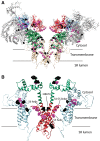The clinical and genetic spectrum of catecholaminergic polymorphic ventricular tachycardia: findings from an international multicentre registry
- PMID: 28158428
- PMCID: PMC6059141
- DOI: 10.1093/europace/euw389
The clinical and genetic spectrum of catecholaminergic polymorphic ventricular tachycardia: findings from an international multicentre registry
Abstract
Aims: Catecholaminergic polymorphic ventricular tachycardia (CPVT) is an ion channelopathy characterized by ventricular arrhythmia during exertion or stress. Mutations in RYR2-coded Ryanodine Receptor-2 (RyR2) and CASQ2-coded Calsequestrin-2 (CASQ2) genes underlie CPVT1 and CPVT2, respectively. However, prognostic markers are scarce. We sought to better characterize the phenotypic and genotypic spectrum of CPVT, and utilize molecular modelling to help account for clinical phenotypes.
Methods and results: This is a Pediatric and Congenital Electrophysiology Society multicentre, retrospective cohort study of CPVT patients diagnosed at <19 years of age and their first-degree relatives. Genetic testing was undertaken in 194 of 236 subjects (82%) during 3.5 (1.4-5.3) years of follow-up. The majority (60%) had RyR2-associated CPVT1. Variant locations were predicted based on a 3D structural model of RyR2. Specific residues appear to have key structural importance, supported by an association between cardiac arrest and mutations in the intersubunit interface of the N-terminus, and the S4-S5 linker and helices S5 and S6 of the RyR2 C-terminus. In approximately one quarter of symptomatic patients, cardiac events were precipitated by only normal wakeful activities.
Conclusion: This large, multicentre study identifies contemporary challenges related to the diagnosis and prognostication of CPVT patients. Structural modelling of RyR2 can improve our understanding severe CPVT phenotypes. Wakeful rest, rather than exertion, often precipitated life-threatening cardiac events.
Published on behalf of the European Society of Cardiology. All rights reserved. © The Author 2017. For Permissions, please email: journals.permissions@oup.com.
Figures




References
-
- Leenhardt A, Lucet V, Denjoy I, Grau F, Do Ngoc D, Coumel P.. Catecholaminergic polymorphic ventricular tachycardia in children: a 7-year follow-up of 21 patients. Circulation 1995;91:1512–9. - PubMed
-
- Priori S, Napolitano C, Tiso N, Memmi M, Vignati G, Bloise R. et al. Mutations in the cardiac ryanodine receptor gene (hRyR2) underlie catecholaminergic polymorphic ventricular tachycardia. Circulation 2001;103:196–200. - PubMed
-
- Hayashi M, Denjoy I, Extramiana F, Maltret A, Roux-Buisson N, Lupoglazoff J. et al. Incidence and risk factors of arrhythmic events in catecholaminergic polymorphic ventricular tachycardia. Circulation 2009;119:2426–34. - PubMed

